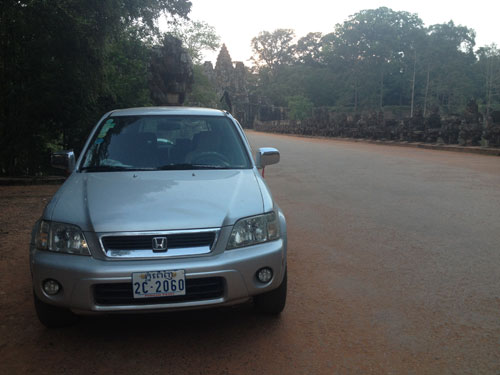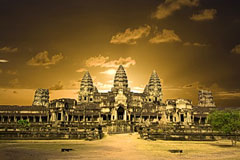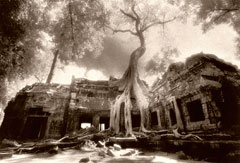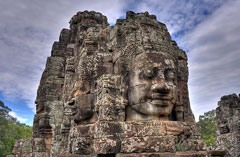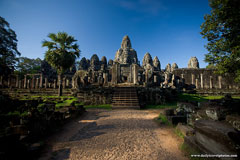Sam Pho - the tour guide and driver - your choice for Siem Reap Angkor Wat touring!
Understanding
The name Siem Reap literally means "Siam Defeated". These days, however, the only rampaging hordes are the tourists heading to the Angkor Archaeological Park. This once quaint village has become the largest boomtown and construction site in Cambodia. It is quite laid-back and a pleasant place to stay while touring the temples. It is a nice compromise between observing Cambodian life and enjoying the amenities of modern services and entertainment, thanks to a large expatriate community. Since Siem Reap is a major tourist destination, prices in some instances are higher than elsewhere in Cambodia.
Admission / How Long to Stay
You must possess an admission pass (an 'Angkor Pass') to visit the temples and sites in the Angkor Archaeological Park. Passes may be purchased at the main entrance on the road to Angkor Wat.
Passes are sold in one-day ($37), three-day ($62) and seven-day ($72) blocks. The three day pass is valid for one week, i.e. 3 days to be used within the week, not necessarily consecutively. The seven day pass is valid for one month, i.e. 7 days to be used within the month, not necessarily consecutively.
A one-day visit allows you to see the highlights of the most famous temples but very little more. Three days is sufficient to visit all of the major temples once, a few of the minor ones and have a little extra time at your favorites. Seven days is enough time to really explore some of your favorite ruins and visit many of the minor structures as well. One passport-sized photo is require at time of purchase of three and seven day passes. If you do not have a photo, free photos are provided at the main entrance, though this can be a time consuming process at peak entrance hours.
Visiting hours are 5:00AM - 6:00PM. Angkor Wat closes at 6:00PM, Bantey Srei closes at 5:00PM and Khbal Spean at 3:00PM. Always carry your ticket. It will be checked upon each park entry and at major temples. There is a significant fine for not possessing a valid ticket inside the park. A regular admission ticket is not required to visit Phnom Kulen, Koh Ker, Beng Mealea and Tonle Sap Boat Tours to Kompong Phluk or Kompong Khleang the fishing village on stilts but there is a separate entrance fee of $20 per person, $10 and $5 and $ 20 ( admission fee included boat tours around there 2 hours ) respectively.
What to Brings and Wears
Wear light, airy, covering clothing to protect yourself from the sun and mosquitoes but remember Angkor Wat and Baphoun temple required dress code must wear proper dress ( t-shirt to covers your shoulders and pant or skirt covers your knees ). The sun can be intense so bring a hat, sunglasses and perhaps sunscreen. Consider buying a traditional Khmer scarf (krama) to keep the sun off your neck. Carry a raincoat during the wet season, though you will probably only need it in the afternoon. You should have mosquito repellent for sunrise and sunset hours. Wear practical shoes for climbing narrow steps and walking on uneven surfaces. For serious temple explorers, a flashlight, notebook and compass can come in handy. Books, refreshments, trinkets, postcards and film are available from small vendors throughout the temple complex.
Visas
All visitors, except citizens of Indonesia, Malaysia, Singapore, Philippines, Laos, Thailand and Vietnam need a visa to enter Cambodia. The official price for a tourist visa is US$30. Staff may try to charge more at some land border crossings: hold out for the official price, particularly at major crossings, but don't be upset if you have to pay US$1-2 extra.
Visas can be obtained at Cambodian embassies or consulates. Visas are also available "on arrival" at both international airports, all six international border crossings with Thailand, some international border crossings with Vietnam, and at the main border crossing with Laos.
Tourist Viasa all are valid for one stay of up to 30 days. Those issued in advance expire 90 days after issue. In Phnom Penh (or elsewhere via agencies), tourist visas can be extended only once, allowing an additional 30 days at a cost of US$15.
You need to print two copies (one for entry and one for exit) of the PDF visa, cut out the visa parts and keep them with your passport.
Visas in advance (either online or from an embassy/consulate) save time at the border but are more expensive. However, you do get to skip the queues of people applying for the visas arrival, although sometimes you may simply spend the saved time waiting at the airport luggage belt for your suitcase.
E-Visas are only valid for entry by air or at the three border main land crossings only https://www.evisa.gov.kh/
: Bavet (on the Ho Chi Minh City - Phnom Penh Road); Koh Kong (near Trat in Eastern Thailand); and Poipet (on the Bangkok - Siem Reap RRoad). You may exit the country with e-visa via any border crossing, however. Given the general reduction in visa scams at the major land borders, paying the extra $5 to guarantee the price may (more likely if entering from Thailand) or may not worth it. Getting a tourist visa on arrival for US$20 is more likely than being overcharged. Plus it keeps the option open of the enjoyable Phnom Penh - Chau Doc boat trip (and the use of other minor border crossings)!
Air-Port Departure Tax
The International departure tax of US$25 fee is included in the ticket price. The $12 Domestic departure tax is still paid at the airport. Try to pay in cash as the credit card facilities are unreliable.
Ruin Temples And Attractions
Angkor Wat Temple
Angkor Wat, which literally means ‘City Temple’, is a Hindu temple complex built to replicate the heavens on earth. Constructed for King Suryavarman II in the early twelfth century, it is the best-preserved temple and is the only one to have remained a significant religious centre since its foundation. The temple is the epitome of the high classical style of Khmer architecture.
Angkor Thom City
Angkor Thom City is a very popular tourist spot. It was established in the late twelfth century to early fifthteen century by King Jayavarman VII. This site is situated 1.7 Km north of Angkor Wat, within which are located several monuments from earlier eras as well as those established by Jayavarman VII and his successors.
Bayon Temple
Bayon is a richly decorated Khmer temple built in the late twelfth century or early thirteenth century. Built at the centre of King Jayavarman’s capital, Angkor Thom was the last state temple to be built at Angkor, and the only Angkorian state temple to be built primarily as a Mahayana Buddhist shrine dedicated to the Buddha. Following Jayavarman’s death, it was modified and augmented by later Hindu and Theravada Buddhist kings in accordance to their religious preferences.
Banteay Srei Temple
Consecrated in 967 A.D, Banteay Srei was speculated to have been known earlier as Banteay Serai, which literally means the Citadel of Victory. This was the only major temple at Angkor not built by a monarch; its construction is credited to a courtier named Yajnavaraha, who was a scholar and philanthropist and a counselor to king Rajendravarman. He was known to have helped those who suffered from illness, injustice or poverty.
Phnom Bakheng
Phnom Bakheng was constructed more than two centuries before the Angkor Wat. It is a Hindu temple originally built in the form of a temple mountain dedicated to Shiva. Historians believe that Phnom Bakheng was in its heyday, the principal temple of the Angkor region. It was the architectural centerpiece of a new capital that Yasovarman built when he moved the court from the capital Hariharalaya in the Roluos area located to the southeast.
Preah Khan Temple
Preah Khan was built on the site of Jayavarman VII’s victory over the invading Chams in 1191. In its heyday, this was the centre of a substantial organisation with almost 100,000 officials and servants. This temple is flat in design, with a basic plan of successive rectangular galleries around a Buddhist sanctuary complicated by Hindu satellite temples and numerous later additions. With numerous trees and other vegetation growing among the ruins, Preah Khan has been left largely unrestored.
Ta Phrom Temple
Ta Prohm, a Bayon style temple, is believed to be built in the late twelfth and early thirteenth centuries. It was founded by King Jayavarman VII as a Mahayana Buddhist monastery and university. Unlike most Angkorian temples, Ta Prohm has been left in much the same condition in which it was found where the photogenic and atmospheric combination of trees growing out of the ruins and the jungle surroundings have made it one of Angkor’s most popular temples with visitors.
Kulen Mountain National Park
The Kulen Mountain or Phnom Kulen is declared as a National Park. It is an isolated mountain massif located in Svay Leu District and some 48km from Siem Reap. Its highest point is 487 meters. This is widely regarded as the birthplace of the ancient Khmer Empire. During the constructional period of the ancient temples in the nineth century, sand stones were brought from this sacred mountain to Angkor. It was here at Phnom Kulen that King Jayavarman II proclaimed independence from Java in 802 A.D.
Tonle Sap Lake
Tonle Sap, the largest freshwater lake in Southeast Asia, is itself a natural wonder.This great lake exists as an ecological anomaly. In early June, at the start of the rainy season, the water level of the Mekong River rises to divert part of its flow off its course to the South China Sea and redirect it into the Tonle Sap. This forces the current to reverse direction, beginning a process that by the end of October will see the great lake increasing its size almost tenfold, making it the largest freshwater body in Southeast Asia.
Angkor National Museum
The Angkor National Museum tickets $ 12 per person and is classified as one of Cambodia’s premier museum sites. On display are thousands of important Buddhist and Hindu sculptures from the various Angkor temples. Many original pieces recovered for safe-keeping by the authorities from the temple ruins are also on exhibit at this museum.
Cambodian Cultural Village
The Cambodian Cultural Village is designed to provide tourists with an excellent insight into the life and culture of the Cambodians; their traditions and practices, etc. In all, eleven villages or sectors, each a showcase of different landmarks and providing a peek into the lifestyles of the people from various provinces including the ethnic minorities.
Siem Reap Night Market
Like the one in Phnom Penh, the Angkor Night Market is also designed to give visitors a secure and enjoyable shopping and dining experience in a vibrant, contemporary Khmer environment. Both these night markets offer a wide variety of stalls offering a diverse range of goods and services. A ‘must visit’ when in the vicinity.
Beng Melea Temple
The remains of Beng Mealea, which are still partly buried under vegetation and more jungles, consist of perfectly squared-off sandstone building blocks. The outstanding decoration dates from the fist half of the 12th century.
Pre Rub Temple
Architecturally and artistically superior temple-mountain. Beautifully carved false doors on upper level, as well as an excellent view of the surrounding countryside. Richly detailed, Well-preserved carvings.
Khbal Spean
It is located at the top of the Kulen Mountain located 50 km a way. Along the river of Siem Reap, there are a lot of figures of Yoni and Linga ( numerious carvings under riverbed included phallic symbol male and fimale organs ) spreading out at its bottom.
Banteay Samre
Large, comparatively flat temple displaying distinctively Angkor Wat-style architecture and artistry. The temple underwent extensive restoration this century by archaeologists using the anastylosis method. Banteay Samre was constructed around the same time as Angkor Wat.
Baray
A Baray is an acient water reservoir – an area of land where dikes have been raised to catch and hold water. Beginning in the 9th century, the construction of massive baray and other such grand projects became one of the marks of Angkorian kingship.
Koh Ker Temple
The temple complex at Koh Ker, northeast of Siem Reap, represents the remnants of the capital of the Khmer Empire from 928 AD. – 944 A.D. – a very unique period in the Age of Angkor. From the time the Khmer capital was first moved to the Angkor area in the late 9 th century, it would remain there for almost 500 years, with one brief interruption. Just a few decades after the establishment at Angkor there was a disruption in the royal succession for reasons that remain a matter of academic debate. What is known is that in 928 A.D. King Jayavarman IV, possibly a usurper to the throne, created a new capital 100km away at Koh Ker, either moving the capital city from Angkor or creating a rival capital. Obviously a king of much wealth and power, he raised an impressive royal city at Koh Ker of Brahmanic monuments, temples and prasats, surrounding a huge baray (reservoir) Rahal.



